Analyzing Environmental Risks in Maritime Logistics and Hinterland
VerifiedAdded on 2023/06/15
|25
|5232
|94
Report
AI Summary
This report investigates the environmental risks present in maritime logistics and hinterland transport, with a particular focus on the Australian context. It begins by outlining the importance of maritime transport and the increasing environmental concerns associated with port operations. The report identifies various risk factors, including climate change impacts like cyclones and sea-level rise, as well as pollution from water waste and GHG emissions. It emphasizes the role of risk management in mitigating these hazards and highlights the need for stakeholder engagement and policy implementation. The research methodology involves both primary data collection through surveys and interviews, and secondary data analysis from government reports and academic literature, aiming to provide recommendations for sustainable practices and integrated decision support in the maritime industry. Desklib offers a wealth of similar resources for students.
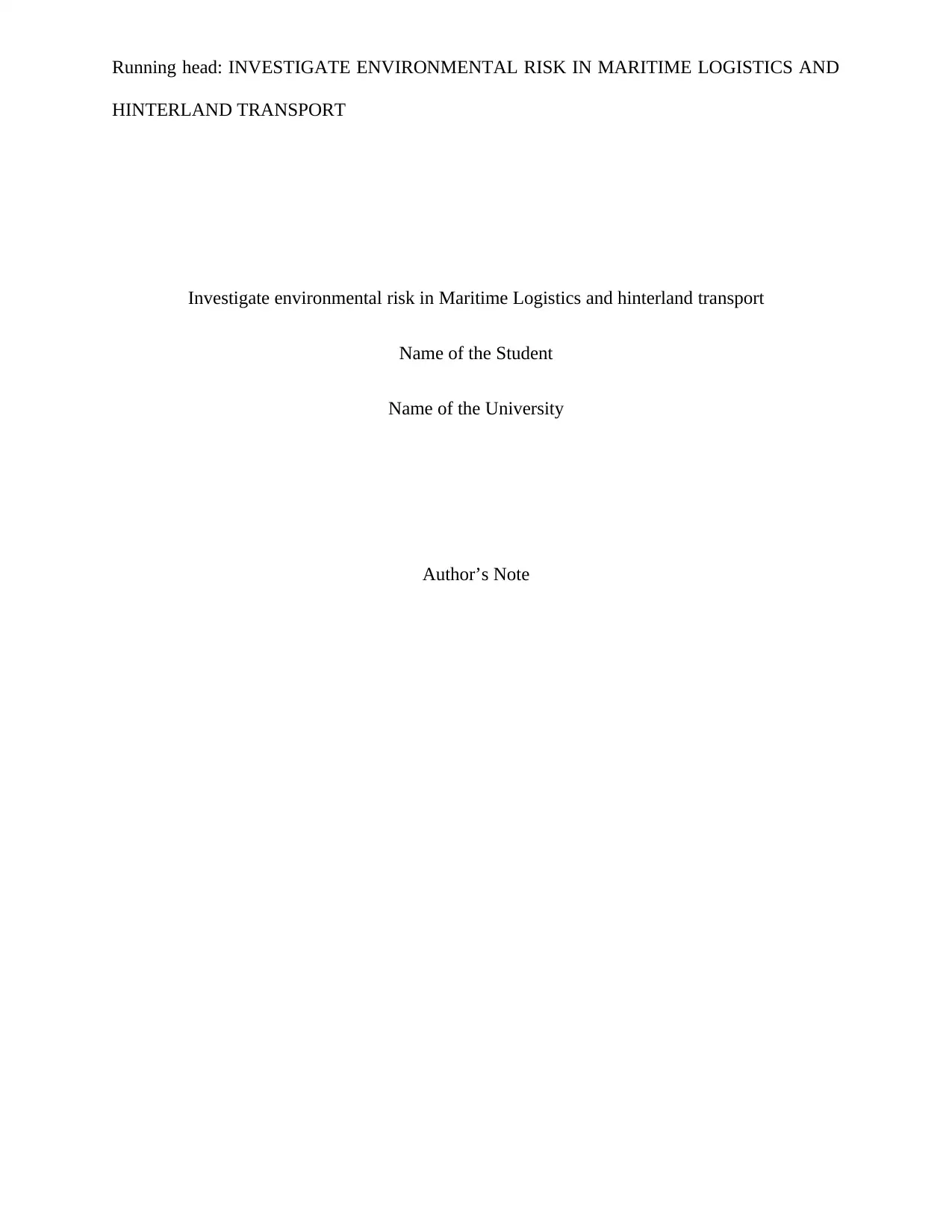
Running head: INVESTIGATE ENVIRONMENTAL RISK IN MARITIME LOGISTICS AND
HINTERLAND TRANSPORT
Investigate environmental risk in Maritime Logistics and hinterland transport
Name of the Student
Name of the University
Author’s Note
HINTERLAND TRANSPORT
Investigate environmental risk in Maritime Logistics and hinterland transport
Name of the Student
Name of the University
Author’s Note
Paraphrase This Document
Need a fresh take? Get an instant paraphrase of this document with our AI Paraphraser
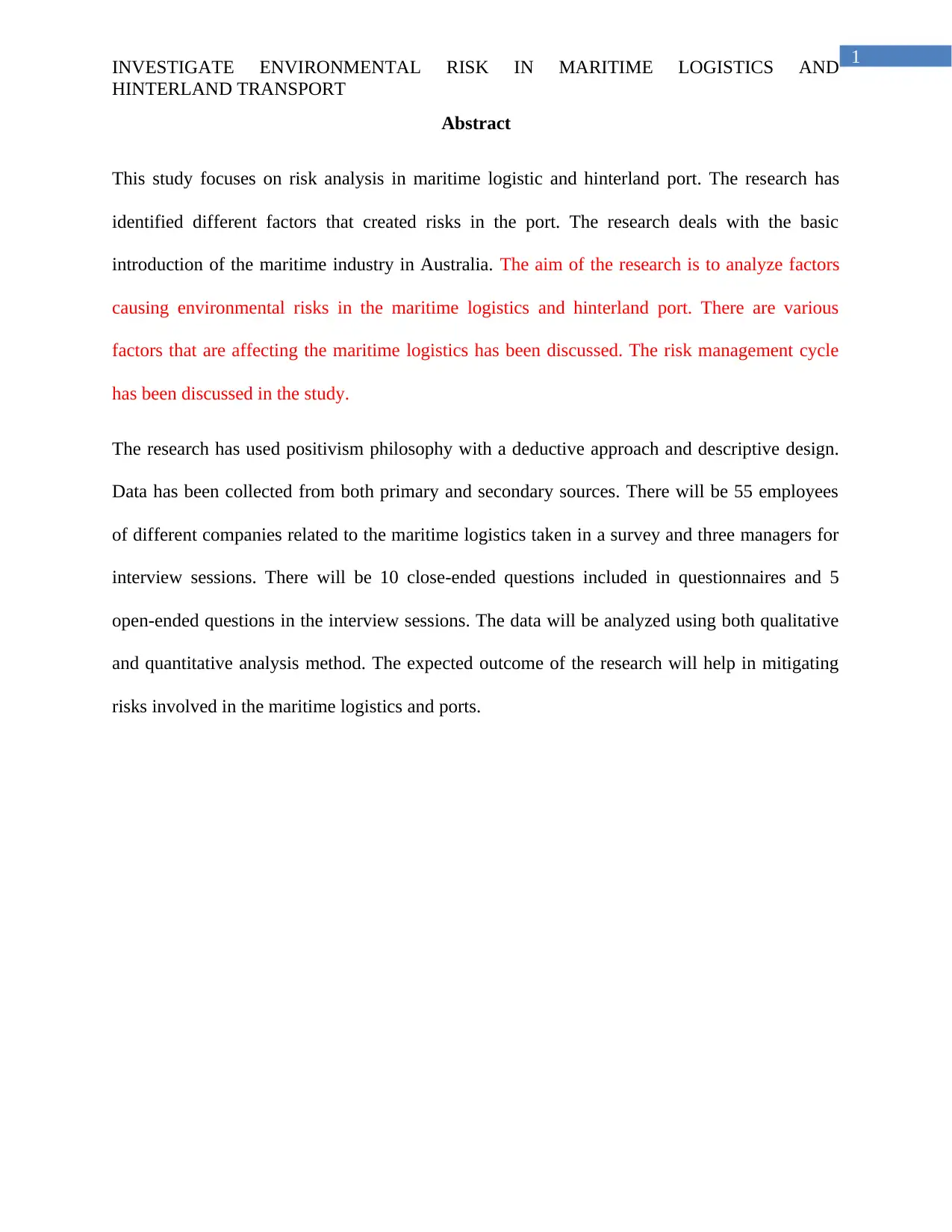
1
INVESTIGATE ENVIRONMENTAL RISK IN MARITIME LOGISTICS AND
HINTERLAND TRANSPORT
Abstract
This study focuses on risk analysis in maritime logistic and hinterland port. The research has
identified different factors that created risks in the port. The research deals with the basic
introduction of the maritime industry in Australia. The aim of the research is to analyze factors
causing environmental risks in the maritime logistics and hinterland port. There are various
factors that are affecting the maritime logistics has been discussed. The risk management cycle
has been discussed in the study.
The research has used positivism philosophy with a deductive approach and descriptive design.
Data has been collected from both primary and secondary sources. There will be 55 employees
of different companies related to the maritime logistics taken in a survey and three managers for
interview sessions. There will be 10 close-ended questions included in questionnaires and 5
open-ended questions in the interview sessions. The data will be analyzed using both qualitative
and quantitative analysis method. The expected outcome of the research will help in mitigating
risks involved in the maritime logistics and ports.
INVESTIGATE ENVIRONMENTAL RISK IN MARITIME LOGISTICS AND
HINTERLAND TRANSPORT
Abstract
This study focuses on risk analysis in maritime logistic and hinterland port. The research has
identified different factors that created risks in the port. The research deals with the basic
introduction of the maritime industry in Australia. The aim of the research is to analyze factors
causing environmental risks in the maritime logistics and hinterland port. There are various
factors that are affecting the maritime logistics has been discussed. The risk management cycle
has been discussed in the study.
The research has used positivism philosophy with a deductive approach and descriptive design.
Data has been collected from both primary and secondary sources. There will be 55 employees
of different companies related to the maritime logistics taken in a survey and three managers for
interview sessions. There will be 10 close-ended questions included in questionnaires and 5
open-ended questions in the interview sessions. The data will be analyzed using both qualitative
and quantitative analysis method. The expected outcome of the research will help in mitigating
risks involved in the maritime logistics and ports.
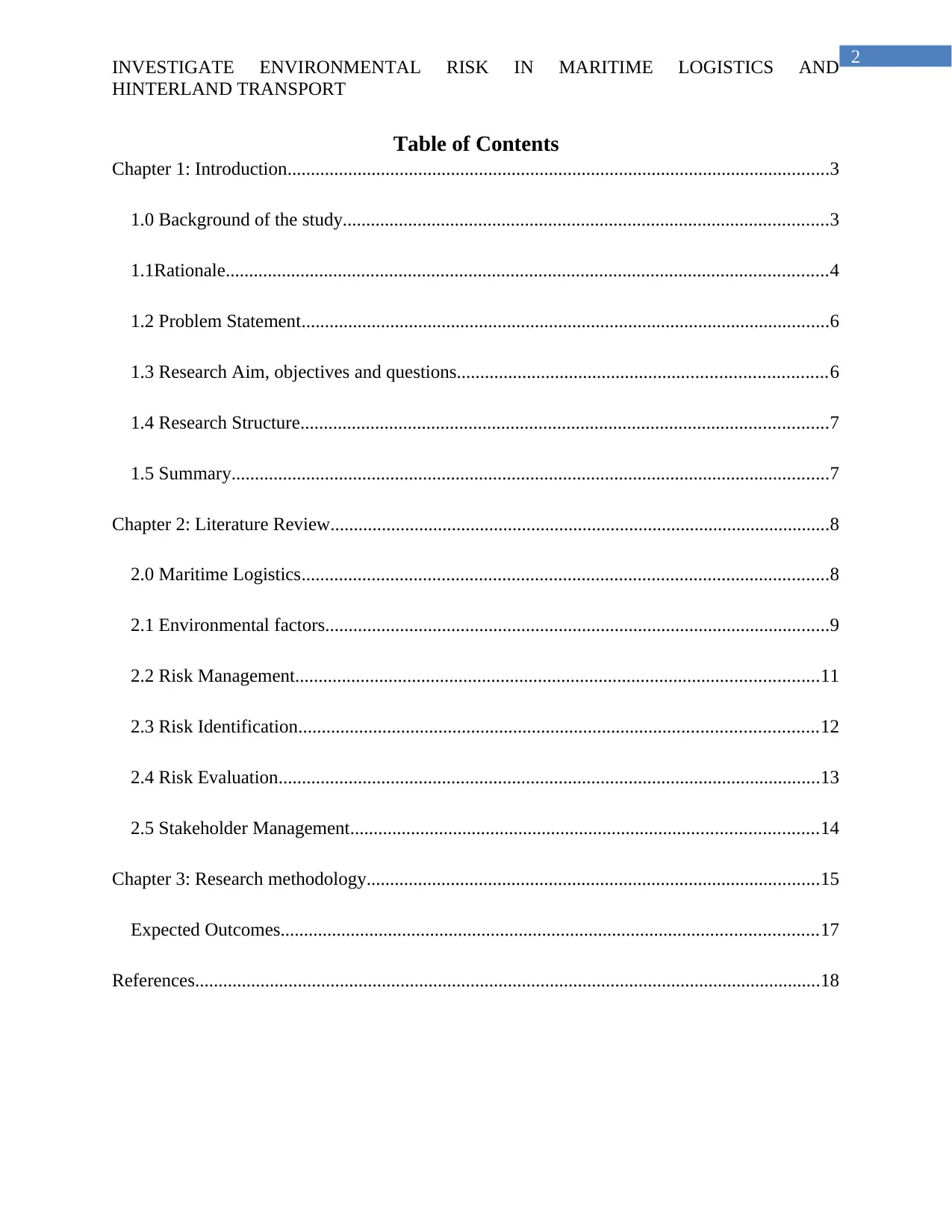
2
INVESTIGATE ENVIRONMENTAL RISK IN MARITIME LOGISTICS AND
HINTERLAND TRANSPORT
Table of Contents
Chapter 1: Introduction....................................................................................................................3
1.0 Background of the study........................................................................................................3
1.1Rationale.................................................................................................................................4
1.2 Problem Statement.................................................................................................................6
1.3 Research Aim, objectives and questions...............................................................................6
1.4 Research Structure.................................................................................................................7
1.5 Summary................................................................................................................................7
Chapter 2: Literature Review...........................................................................................................8
2.0 Maritime Logistics.................................................................................................................8
2.1 Environmental factors............................................................................................................9
2.2 Risk Management................................................................................................................11
2.3 Risk Identification...............................................................................................................12
2.4 Risk Evaluation....................................................................................................................13
2.5 Stakeholder Management....................................................................................................14
Chapter 3: Research methodology.................................................................................................15
Expected Outcomes...................................................................................................................17
References......................................................................................................................................18
INVESTIGATE ENVIRONMENTAL RISK IN MARITIME LOGISTICS AND
HINTERLAND TRANSPORT
Table of Contents
Chapter 1: Introduction....................................................................................................................3
1.0 Background of the study........................................................................................................3
1.1Rationale.................................................................................................................................4
1.2 Problem Statement.................................................................................................................6
1.3 Research Aim, objectives and questions...............................................................................6
1.4 Research Structure.................................................................................................................7
1.5 Summary................................................................................................................................7
Chapter 2: Literature Review...........................................................................................................8
2.0 Maritime Logistics.................................................................................................................8
2.1 Environmental factors............................................................................................................9
2.2 Risk Management................................................................................................................11
2.3 Risk Identification...............................................................................................................12
2.4 Risk Evaluation....................................................................................................................13
2.5 Stakeholder Management....................................................................................................14
Chapter 3: Research methodology.................................................................................................15
Expected Outcomes...................................................................................................................17
References......................................................................................................................................18
⊘ This is a preview!⊘
Do you want full access?
Subscribe today to unlock all pages.

Trusted by 1+ million students worldwide
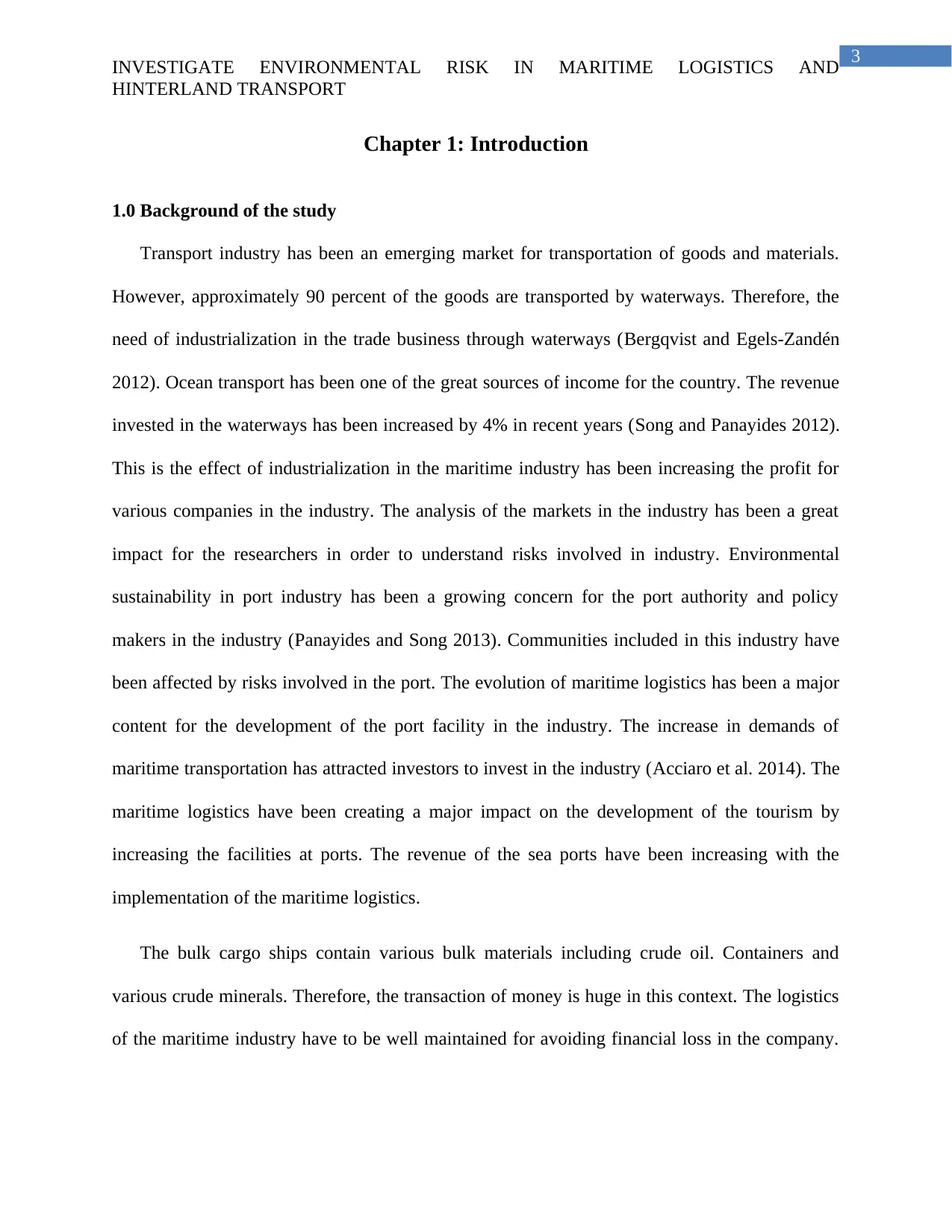
3
INVESTIGATE ENVIRONMENTAL RISK IN MARITIME LOGISTICS AND
HINTERLAND TRANSPORT
Chapter 1: Introduction
1.0 Background of the study
Transport industry has been an emerging market for transportation of goods and materials.
However, approximately 90 percent of the goods are transported by waterways. Therefore, the
need of industrialization in the trade business through waterways (Bergqvist and Egels-Zandén
2012). Ocean transport has been one of the great sources of income for the country. The revenue
invested in the waterways has been increased by 4% in recent years (Song and Panayides 2012).
This is the effect of industrialization in the maritime industry has been increasing the profit for
various companies in the industry. The analysis of the markets in the industry has been a great
impact for the researchers in order to understand risks involved in industry. Environmental
sustainability in port industry has been a growing concern for the port authority and policy
makers in the industry (Panayides and Song 2013). Communities included in this industry have
been affected by risks involved in the port. The evolution of maritime logistics has been a major
content for the development of the port facility in the industry. The increase in demands of
maritime transportation has attracted investors to invest in the industry (Acciaro et al. 2014). The
maritime logistics have been creating a major impact on the development of the tourism by
increasing the facilities at ports. The revenue of the sea ports have been increasing with the
implementation of the maritime logistics.
The bulk cargo ships contain various bulk materials including crude oil. Containers and
various crude minerals. Therefore, the transaction of money is huge in this context. The logistics
of the maritime industry have to be well maintained for avoiding financial loss in the company.
INVESTIGATE ENVIRONMENTAL RISK IN MARITIME LOGISTICS AND
HINTERLAND TRANSPORT
Chapter 1: Introduction
1.0 Background of the study
Transport industry has been an emerging market for transportation of goods and materials.
However, approximately 90 percent of the goods are transported by waterways. Therefore, the
need of industrialization in the trade business through waterways (Bergqvist and Egels-Zandén
2012). Ocean transport has been one of the great sources of income for the country. The revenue
invested in the waterways has been increased by 4% in recent years (Song and Panayides 2012).
This is the effect of industrialization in the maritime industry has been increasing the profit for
various companies in the industry. The analysis of the markets in the industry has been a great
impact for the researchers in order to understand risks involved in industry. Environmental
sustainability in port industry has been a growing concern for the port authority and policy
makers in the industry (Panayides and Song 2013). Communities included in this industry have
been affected by risks involved in the port. The evolution of maritime logistics has been a major
content for the development of the port facility in the industry. The increase in demands of
maritime transportation has attracted investors to invest in the industry (Acciaro et al. 2014). The
maritime logistics have been creating a major impact on the development of the tourism by
increasing the facilities at ports. The revenue of the sea ports have been increasing with the
implementation of the maritime logistics.
The bulk cargo ships contain various bulk materials including crude oil. Containers and
various crude minerals. Therefore, the transaction of money is huge in this context. The logistics
of the maritime industry have to be well maintained for avoiding financial loss in the company.
Paraphrase This Document
Need a fresh take? Get an instant paraphrase of this document with our AI Paraphraser
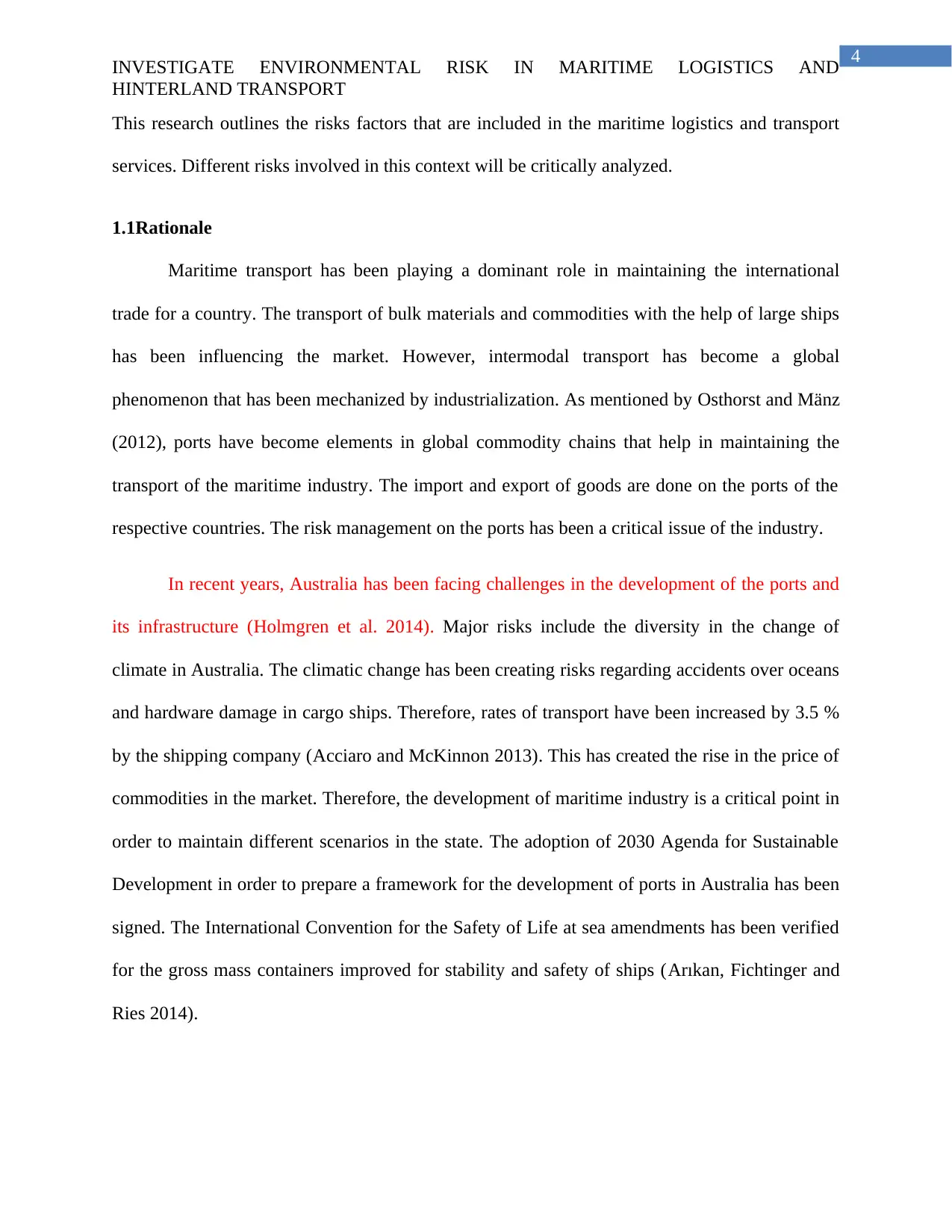
4
INVESTIGATE ENVIRONMENTAL RISK IN MARITIME LOGISTICS AND
HINTERLAND TRANSPORT
This research outlines the risks factors that are included in the maritime logistics and transport
services. Different risks involved in this context will be critically analyzed.
1.1Rationale
Maritime transport has been playing a dominant role in maintaining the international
trade for a country. The transport of bulk materials and commodities with the help of large ships
has been influencing the market. However, intermodal transport has become a global
phenomenon that has been mechanized by industrialization. As mentioned by Osthorst and Mänz
(2012), ports have become elements in global commodity chains that help in maintaining the
transport of the maritime industry. The import and export of goods are done on the ports of the
respective countries. The risk management on the ports has been a critical issue of the industry.
In recent years, Australia has been facing challenges in the development of the ports and
its infrastructure (Holmgren et al. 2014). Major risks include the diversity in the change of
climate in Australia. The climatic change has been creating risks regarding accidents over oceans
and hardware damage in cargo ships. Therefore, rates of transport have been increased by 3.5 %
by the shipping company (Acciaro and McKinnon 2013). This has created the rise in the price of
commodities in the market. Therefore, the development of maritime industry is a critical point in
order to maintain different scenarios in the state. The adoption of 2030 Agenda for Sustainable
Development in order to prepare a framework for the development of ports in Australia has been
signed. The International Convention for the Safety of Life at sea amendments has been verified
for the gross mass containers improved for stability and safety of ships (Arıkan, Fichtinger and
Ries 2014).
INVESTIGATE ENVIRONMENTAL RISK IN MARITIME LOGISTICS AND
HINTERLAND TRANSPORT
This research outlines the risks factors that are included in the maritime logistics and transport
services. Different risks involved in this context will be critically analyzed.
1.1Rationale
Maritime transport has been playing a dominant role in maintaining the international
trade for a country. The transport of bulk materials and commodities with the help of large ships
has been influencing the market. However, intermodal transport has become a global
phenomenon that has been mechanized by industrialization. As mentioned by Osthorst and Mänz
(2012), ports have become elements in global commodity chains that help in maintaining the
transport of the maritime industry. The import and export of goods are done on the ports of the
respective countries. The risk management on the ports has been a critical issue of the industry.
In recent years, Australia has been facing challenges in the development of the ports and
its infrastructure (Holmgren et al. 2014). Major risks include the diversity in the change of
climate in Australia. The climatic change has been creating risks regarding accidents over oceans
and hardware damage in cargo ships. Therefore, rates of transport have been increased by 3.5 %
by the shipping company (Acciaro and McKinnon 2013). This has created the rise in the price of
commodities in the market. Therefore, the development of maritime industry is a critical point in
order to maintain different scenarios in the state. The adoption of 2030 Agenda for Sustainable
Development in order to prepare a framework for the development of ports in Australia has been
signed. The International Convention for the Safety of Life at sea amendments has been verified
for the gross mass containers improved for stability and safety of ships (Arıkan, Fichtinger and
Ries 2014).
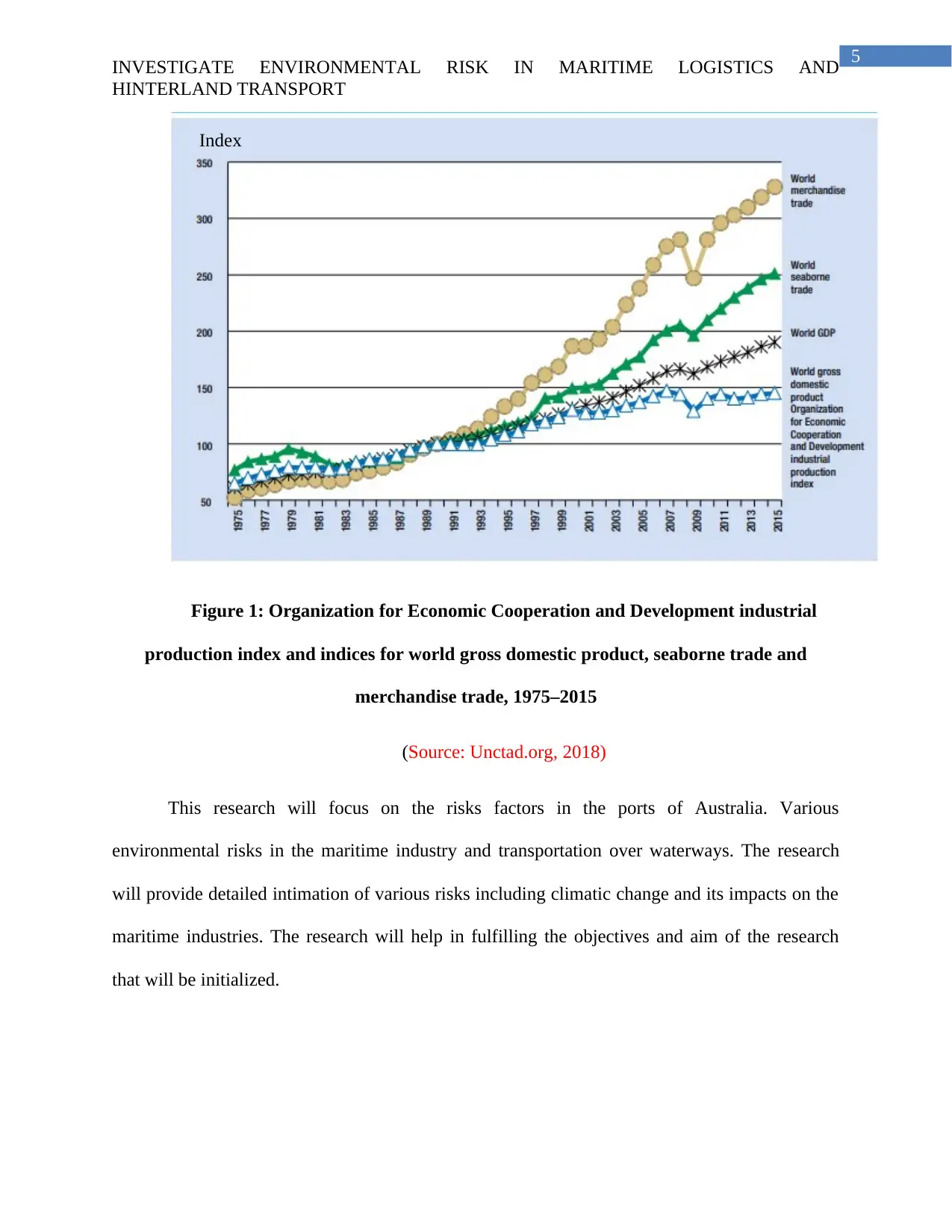
5
INVESTIGATE ENVIRONMENTAL RISK IN MARITIME LOGISTICS AND
HINTERLAND TRANSPORT
Figure 1: Organization for Economic Cooperation and Development industrial
production index and indices for world gross domestic product, seaborne trade and
merchandise trade, 1975–2015
(Source: Unctad.org, 2018)
This research will focus on the risks factors in the ports of Australia. Various
environmental risks in the maritime industry and transportation over waterways. The research
will provide detailed intimation of various risks including climatic change and its impacts on the
maritime industries. The research will help in fulfilling the objectives and aim of the research
that will be initialized.
Index
value
INVESTIGATE ENVIRONMENTAL RISK IN MARITIME LOGISTICS AND
HINTERLAND TRANSPORT
Figure 1: Organization for Economic Cooperation and Development industrial
production index and indices for world gross domestic product, seaborne trade and
merchandise trade, 1975–2015
(Source: Unctad.org, 2018)
This research will focus on the risks factors in the ports of Australia. Various
environmental risks in the maritime industry and transportation over waterways. The research
will provide detailed intimation of various risks including climatic change and its impacts on the
maritime industries. The research will help in fulfilling the objectives and aim of the research
that will be initialized.
Index
value
⊘ This is a preview!⊘
Do you want full access?
Subscribe today to unlock all pages.

Trusted by 1+ million students worldwide
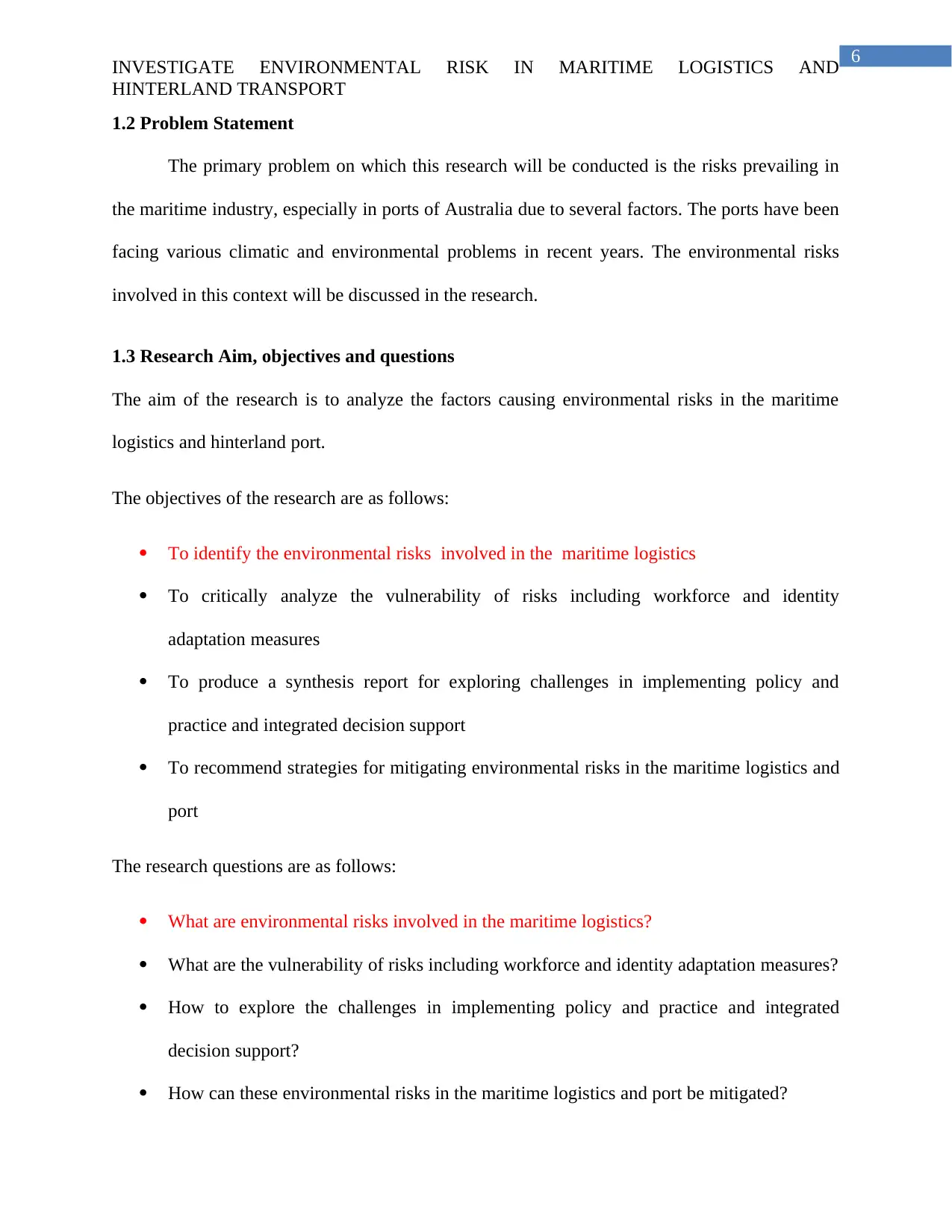
6
INVESTIGATE ENVIRONMENTAL RISK IN MARITIME LOGISTICS AND
HINTERLAND TRANSPORT
1.2 Problem Statement
The primary problem on which this research will be conducted is the risks prevailing in
the maritime industry, especially in ports of Australia due to several factors. The ports have been
facing various climatic and environmental problems in recent years. The environmental risks
involved in this context will be discussed in the research.
1.3 Research Aim, objectives and questions
The aim of the research is to analyze the factors causing environmental risks in the maritime
logistics and hinterland port.
The objectives of the research are as follows:
To identify the environmental risks involved in the maritime logistics
To critically analyze the vulnerability of risks including workforce and identity
adaptation measures
To produce a synthesis report for exploring challenges in implementing policy and
practice and integrated decision support
To recommend strategies for mitigating environmental risks in the maritime logistics and
port
The research questions are as follows:
What are environmental risks involved in the maritime logistics?
What are the vulnerability of risks including workforce and identity adaptation measures?
How to explore the challenges in implementing policy and practice and integrated
decision support?
How can these environmental risks in the maritime logistics and port be mitigated?
INVESTIGATE ENVIRONMENTAL RISK IN MARITIME LOGISTICS AND
HINTERLAND TRANSPORT
1.2 Problem Statement
The primary problem on which this research will be conducted is the risks prevailing in
the maritime industry, especially in ports of Australia due to several factors. The ports have been
facing various climatic and environmental problems in recent years. The environmental risks
involved in this context will be discussed in the research.
1.3 Research Aim, objectives and questions
The aim of the research is to analyze the factors causing environmental risks in the maritime
logistics and hinterland port.
The objectives of the research are as follows:
To identify the environmental risks involved in the maritime logistics
To critically analyze the vulnerability of risks including workforce and identity
adaptation measures
To produce a synthesis report for exploring challenges in implementing policy and
practice and integrated decision support
To recommend strategies for mitigating environmental risks in the maritime logistics and
port
The research questions are as follows:
What are environmental risks involved in the maritime logistics?
What are the vulnerability of risks including workforce and identity adaptation measures?
How to explore the challenges in implementing policy and practice and integrated
decision support?
How can these environmental risks in the maritime logistics and port be mitigated?
Paraphrase This Document
Need a fresh take? Get an instant paraphrase of this document with our AI Paraphraser
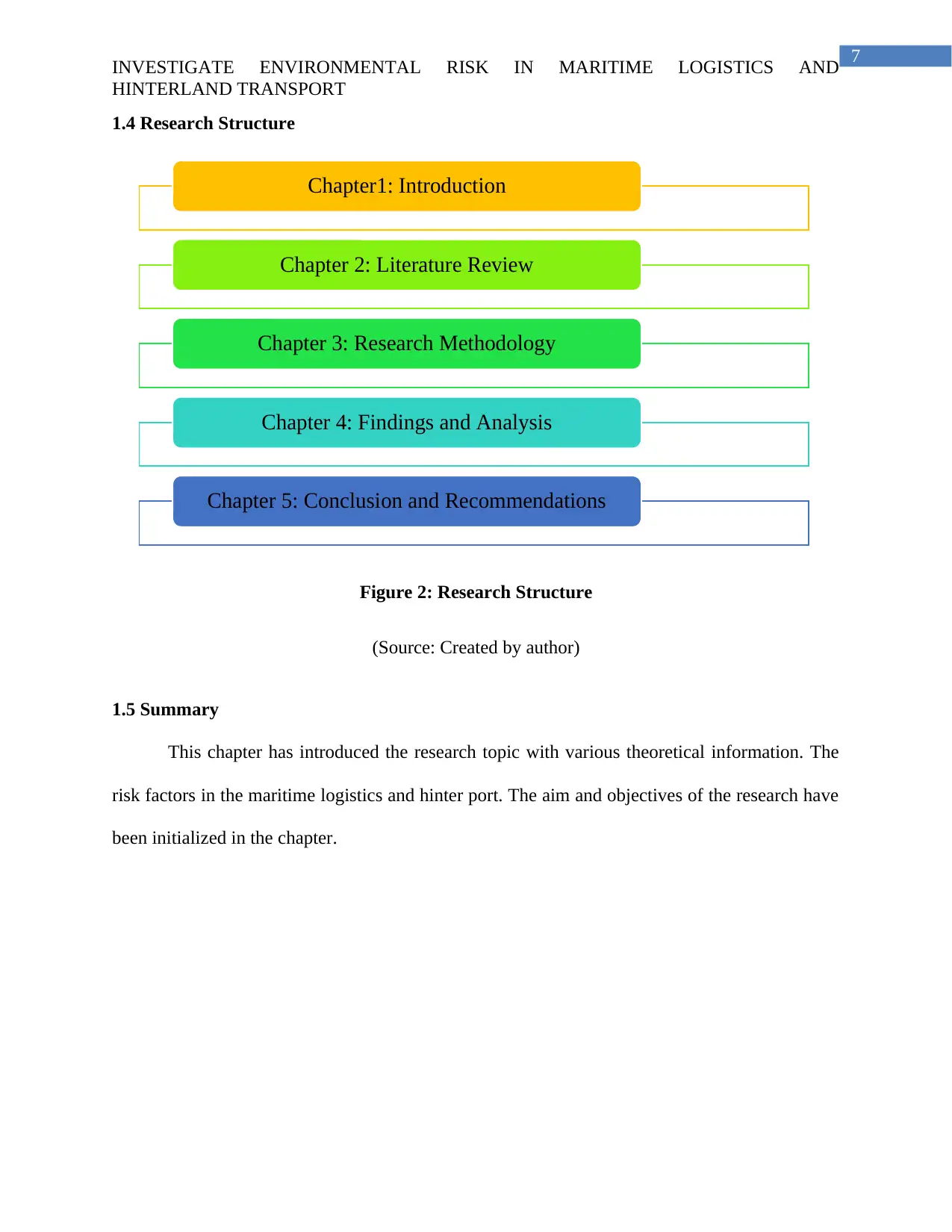
7
INVESTIGATE ENVIRONMENTAL RISK IN MARITIME LOGISTICS AND
HINTERLAND TRANSPORT
1.4 Research Structure
Figure 2: Research Structure
(Source: Created by author)
1.5 Summary
This chapter has introduced the research topic with various theoretical information. The
risk factors in the maritime logistics and hinter port. The aim and objectives of the research have
been initialized in the chapter.
Chapter1: Introduction
Chapter 2: Literature Review
Chapter 3: Research Methodology
Chapter 4: Findings and Analysis
Chapter 5: Conclusion and Recommendations
INVESTIGATE ENVIRONMENTAL RISK IN MARITIME LOGISTICS AND
HINTERLAND TRANSPORT
1.4 Research Structure
Figure 2: Research Structure
(Source: Created by author)
1.5 Summary
This chapter has introduced the research topic with various theoretical information. The
risk factors in the maritime logistics and hinter port. The aim and objectives of the research have
been initialized in the chapter.
Chapter1: Introduction
Chapter 2: Literature Review
Chapter 3: Research Methodology
Chapter 4: Findings and Analysis
Chapter 5: Conclusion and Recommendations
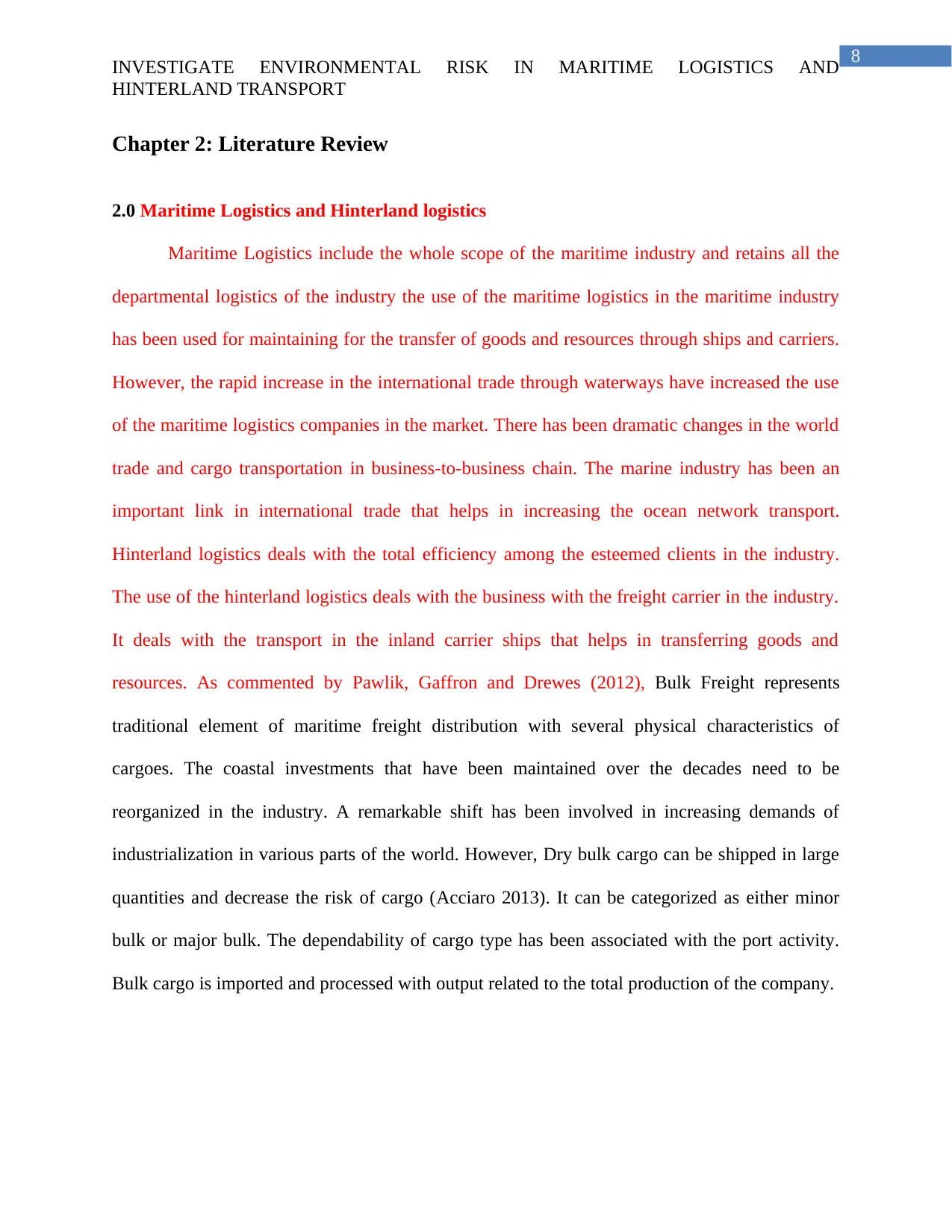
8
INVESTIGATE ENVIRONMENTAL RISK IN MARITIME LOGISTICS AND
HINTERLAND TRANSPORT
Chapter 2: Literature Review
2.0 Maritime Logistics and Hinterland logistics
Maritime Logistics include the whole scope of the maritime industry and retains all the
departmental logistics of the industry the use of the maritime logistics in the maritime industry
has been used for maintaining for the transfer of goods and resources through ships and carriers.
However, the rapid increase in the international trade through waterways have increased the use
of the maritime logistics companies in the market. There has been dramatic changes in the world
trade and cargo transportation in business-to-business chain. The marine industry has been an
important link in international trade that helps in increasing the ocean network transport.
Hinterland logistics deals with the total efficiency among the esteemed clients in the industry.
The use of the hinterland logistics deals with the business with the freight carrier in the industry.
It deals with the transport in the inland carrier ships that helps in transferring goods and
resources. As commented by Pawlik, Gaffron and Drewes (2012), Bulk Freight represents
traditional element of maritime freight distribution with several physical characteristics of
cargoes. The coastal investments that have been maintained over the decades need to be
reorganized in the industry. A remarkable shift has been involved in increasing demands of
industrialization in various parts of the world. However, Dry bulk cargo can be shipped in large
quantities and decrease the risk of cargo (Acciaro 2013). It can be categorized as either minor
bulk or major bulk. The dependability of cargo type has been associated with the port activity.
Bulk cargo is imported and processed with output related to the total production of the company.
INVESTIGATE ENVIRONMENTAL RISK IN MARITIME LOGISTICS AND
HINTERLAND TRANSPORT
Chapter 2: Literature Review
2.0 Maritime Logistics and Hinterland logistics
Maritime Logistics include the whole scope of the maritime industry and retains all the
departmental logistics of the industry the use of the maritime logistics in the maritime industry
has been used for maintaining for the transfer of goods and resources through ships and carriers.
However, the rapid increase in the international trade through waterways have increased the use
of the maritime logistics companies in the market. There has been dramatic changes in the world
trade and cargo transportation in business-to-business chain. The marine industry has been an
important link in international trade that helps in increasing the ocean network transport.
Hinterland logistics deals with the total efficiency among the esteemed clients in the industry.
The use of the hinterland logistics deals with the business with the freight carrier in the industry.
It deals with the transport in the inland carrier ships that helps in transferring goods and
resources. As commented by Pawlik, Gaffron and Drewes (2012), Bulk Freight represents
traditional element of maritime freight distribution with several physical characteristics of
cargoes. The coastal investments that have been maintained over the decades need to be
reorganized in the industry. A remarkable shift has been involved in increasing demands of
industrialization in various parts of the world. However, Dry bulk cargo can be shipped in large
quantities and decrease the risk of cargo (Acciaro 2013). It can be categorized as either minor
bulk or major bulk. The dependability of cargo type has been associated with the port activity.
Bulk cargo is imported and processed with output related to the total production of the company.
⊘ This is a preview!⊘
Do you want full access?
Subscribe today to unlock all pages.

Trusted by 1+ million students worldwide
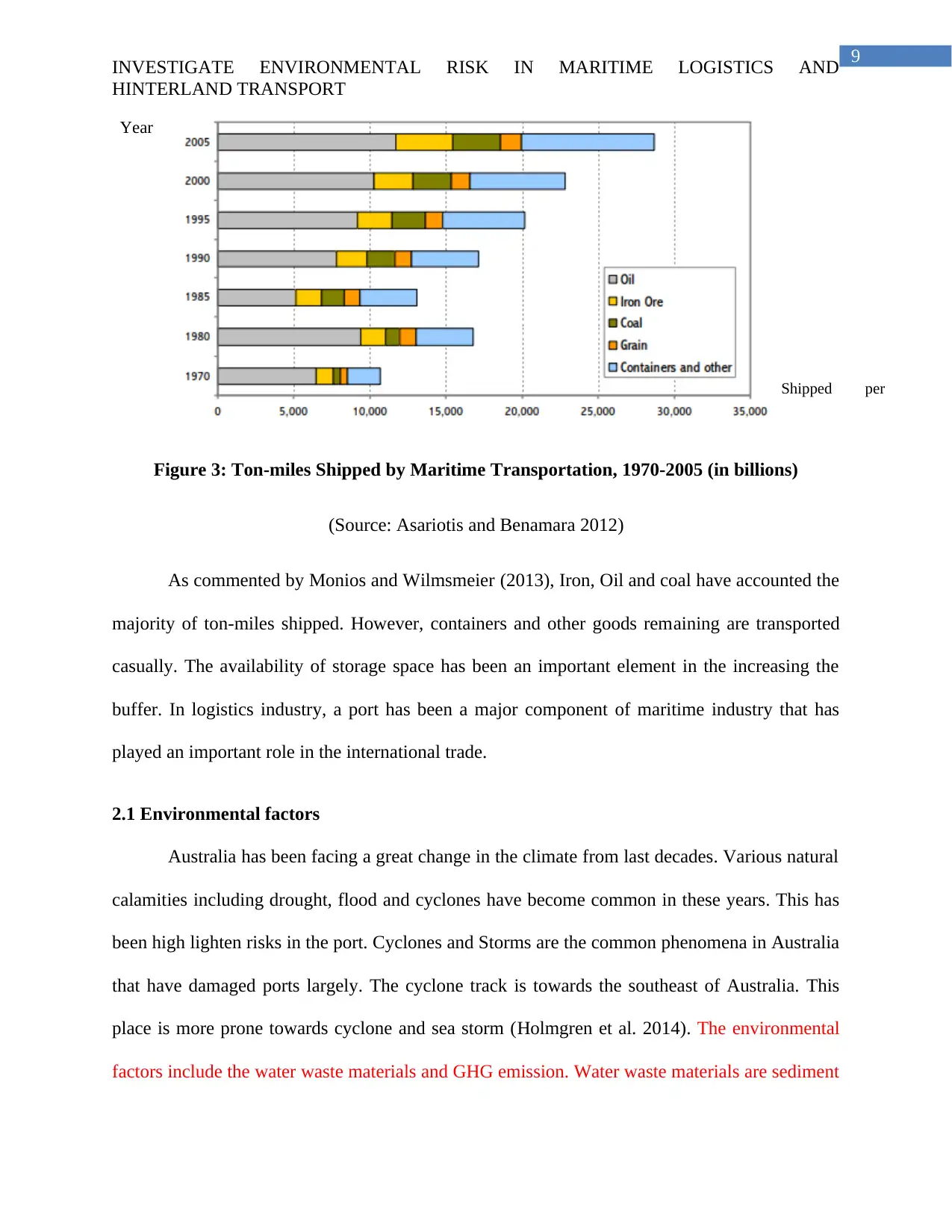
9
INVESTIGATE ENVIRONMENTAL RISK IN MARITIME LOGISTICS AND
HINTERLAND TRANSPORT
Figure 3: Ton-miles Shipped by Maritime Transportation, 1970-2005 (in billions)
(Source: Asariotis and Benamara 2012)
As commented by Monios and Wilmsmeier (2013), Iron, Oil and coal have accounted the
majority of ton-miles shipped. However, containers and other goods remaining are transported
casually. The availability of storage space has been an important element in the increasing the
buffer. In logistics industry, a port has been a major component of maritime industry that has
played an important role in the international trade.
2.1 Environmental factors
Australia has been facing a great change in the climate from last decades. Various natural
calamities including drought, flood and cyclones have become common in these years. This has
been high lighten risks in the port. Cyclones and Storms are the common phenomena in Australia
that have damaged ports largely. The cyclone track is towards the southeast of Australia. This
place is more prone towards cyclone and sea storm (Holmgren et al. 2014). The environmental
factors include the water waste materials and GHG emission. Water waste materials are sediment
Shipped per
tons
Year
INVESTIGATE ENVIRONMENTAL RISK IN MARITIME LOGISTICS AND
HINTERLAND TRANSPORT
Figure 3: Ton-miles Shipped by Maritime Transportation, 1970-2005 (in billions)
(Source: Asariotis and Benamara 2012)
As commented by Monios and Wilmsmeier (2013), Iron, Oil and coal have accounted the
majority of ton-miles shipped. However, containers and other goods remaining are transported
casually. The availability of storage space has been an important element in the increasing the
buffer. In logistics industry, a port has been a major component of maritime industry that has
played an important role in the international trade.
2.1 Environmental factors
Australia has been facing a great change in the climate from last decades. Various natural
calamities including drought, flood and cyclones have become common in these years. This has
been high lighten risks in the port. Cyclones and Storms are the common phenomena in Australia
that have damaged ports largely. The cyclone track is towards the southeast of Australia. This
place is more prone towards cyclone and sea storm (Holmgren et al. 2014). The environmental
factors include the water waste materials and GHG emission. Water waste materials are sediment
Shipped per
tons
Year
Paraphrase This Document
Need a fresh take? Get an instant paraphrase of this document with our AI Paraphraser
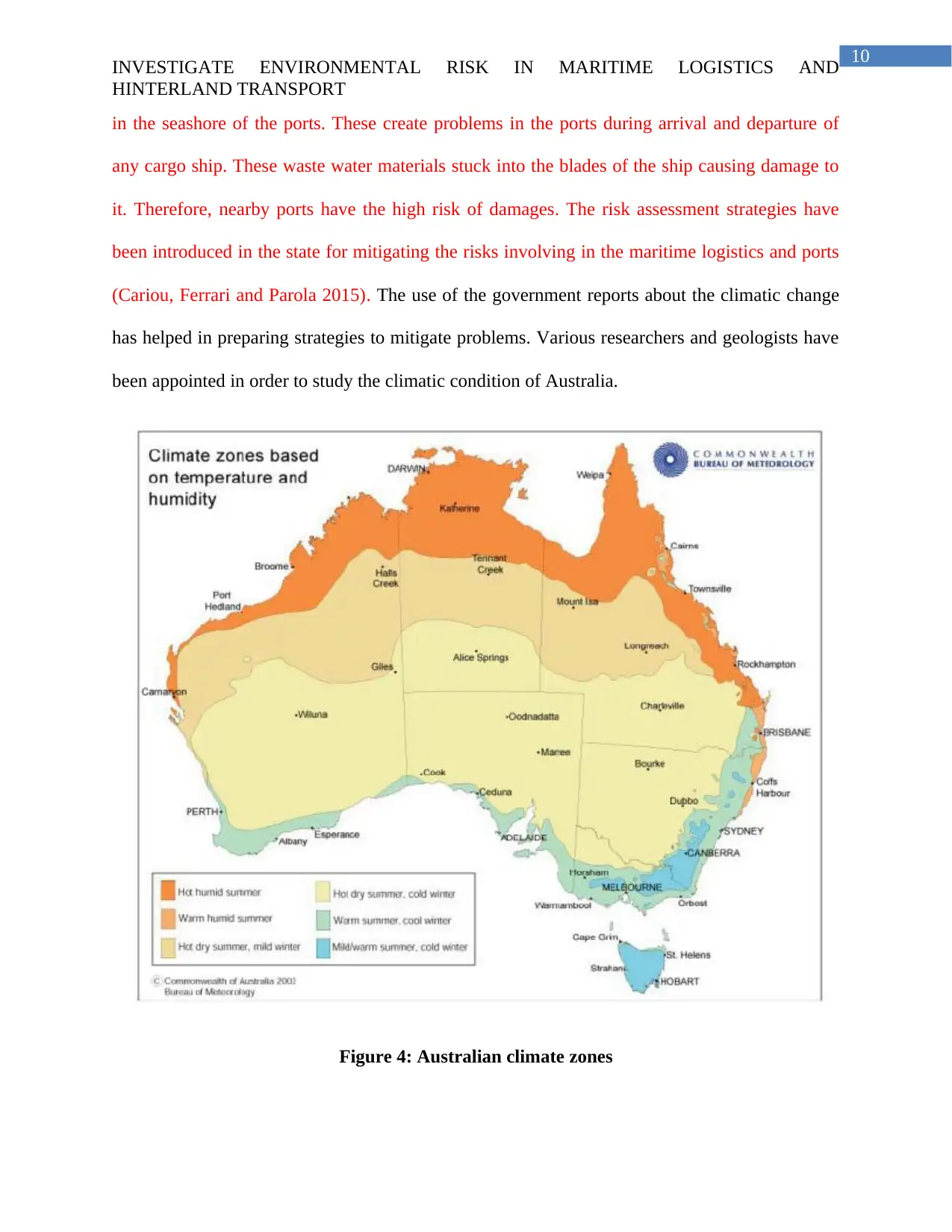
10
INVESTIGATE ENVIRONMENTAL RISK IN MARITIME LOGISTICS AND
HINTERLAND TRANSPORT
in the seashore of the ports. These create problems in the ports during arrival and departure of
any cargo ship. These waste water materials stuck into the blades of the ship causing damage to
it. Therefore, nearby ports have the high risk of damages. The risk assessment strategies have
been introduced in the state for mitigating the risks involving in the maritime logistics and ports
(Cariou, Ferrari and Parola 2015). The use of the government reports about the climatic change
has helped in preparing strategies to mitigate problems. Various researchers and geologists have
been appointed in order to study the climatic condition of Australia.
Figure 4: Australian climate zones
INVESTIGATE ENVIRONMENTAL RISK IN MARITIME LOGISTICS AND
HINTERLAND TRANSPORT
in the seashore of the ports. These create problems in the ports during arrival and departure of
any cargo ship. These waste water materials stuck into the blades of the ship causing damage to
it. Therefore, nearby ports have the high risk of damages. The risk assessment strategies have
been introduced in the state for mitigating the risks involving in the maritime logistics and ports
(Cariou, Ferrari and Parola 2015). The use of the government reports about the climatic change
has helped in preparing strategies to mitigate problems. Various researchers and geologists have
been appointed in order to study the climatic condition of Australia.
Figure 4: Australian climate zones
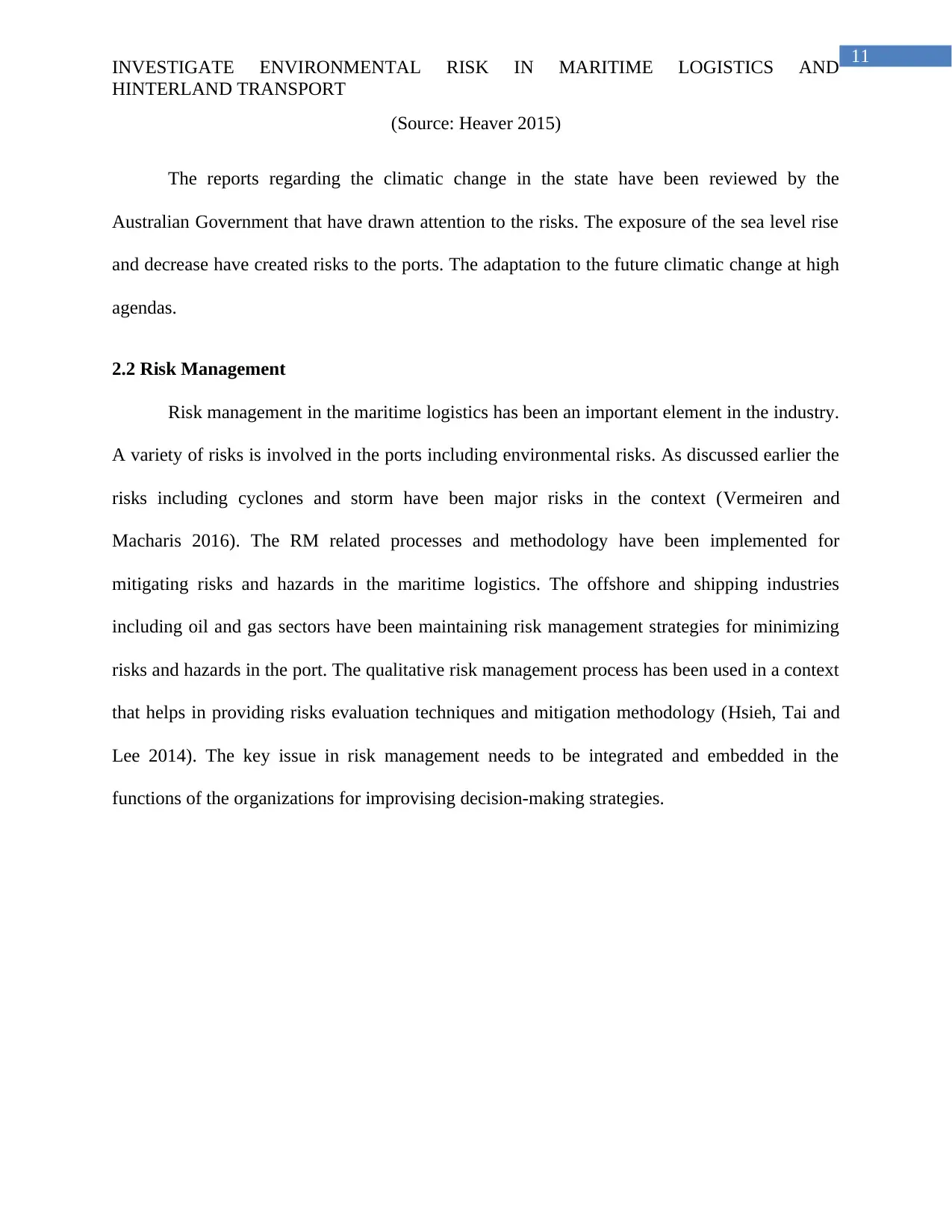
11
INVESTIGATE ENVIRONMENTAL RISK IN MARITIME LOGISTICS AND
HINTERLAND TRANSPORT
(Source: Heaver 2015)
The reports regarding the climatic change in the state have been reviewed by the
Australian Government that have drawn attention to the risks. The exposure of the sea level rise
and decrease have created risks to the ports. The adaptation to the future climatic change at high
agendas.
2.2 Risk Management
Risk management in the maritime logistics has been an important element in the industry.
A variety of risks is involved in the ports including environmental risks. As discussed earlier the
risks including cyclones and storm have been major risks in the context (Vermeiren and
Macharis 2016). The RM related processes and methodology have been implemented for
mitigating risks and hazards in the maritime logistics. The offshore and shipping industries
including oil and gas sectors have been maintaining risk management strategies for minimizing
risks and hazards in the port. The qualitative risk management process has been used in a context
that helps in providing risks evaluation techniques and mitigation methodology (Hsieh, Tai and
Lee 2014). The key issue in risk management needs to be integrated and embedded in the
functions of the organizations for improvising decision-making strategies.
INVESTIGATE ENVIRONMENTAL RISK IN MARITIME LOGISTICS AND
HINTERLAND TRANSPORT
(Source: Heaver 2015)
The reports regarding the climatic change in the state have been reviewed by the
Australian Government that have drawn attention to the risks. The exposure of the sea level rise
and decrease have created risks to the ports. The adaptation to the future climatic change at high
agendas.
2.2 Risk Management
Risk management in the maritime logistics has been an important element in the industry.
A variety of risks is involved in the ports including environmental risks. As discussed earlier the
risks including cyclones and storm have been major risks in the context (Vermeiren and
Macharis 2016). The RM related processes and methodology have been implemented for
mitigating risks and hazards in the maritime logistics. The offshore and shipping industries
including oil and gas sectors have been maintaining risk management strategies for minimizing
risks and hazards in the port. The qualitative risk management process has been used in a context
that helps in providing risks evaluation techniques and mitigation methodology (Hsieh, Tai and
Lee 2014). The key issue in risk management needs to be integrated and embedded in the
functions of the organizations for improvising decision-making strategies.
⊘ This is a preview!⊘
Do you want full access?
Subscribe today to unlock all pages.

Trusted by 1+ million students worldwide
1 out of 25
Related Documents
Your All-in-One AI-Powered Toolkit for Academic Success.
+13062052269
info@desklib.com
Available 24*7 on WhatsApp / Email
![[object Object]](/_next/static/media/star-bottom.7253800d.svg)
Unlock your academic potential
Copyright © 2020–2025 A2Z Services. All Rights Reserved. Developed and managed by ZUCOL.




